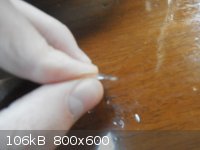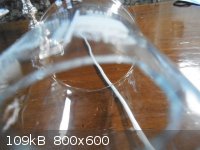Pyro
International Hazard
    
Posts: 1305
Registered: 6-4-2012
Location: Gent, Belgium
Member Is Offline
Mood: No Mood
|
|
is a beaker supposed to be so thin?
hi,
today i was washing my glassware when I accidentally bumped my 400 ml beaker on another piece of glassware, not hard at all and it broke.
the glass there is a little less than a mm thick, is this normal? or is it a production fault?
here are a few pics:
 
all above information is intellectual property of Pyro.  |
|
|
plante1999
International Hazard
    
Posts: 1936
Registered: 27-12-2010
Member Is Offline
Mood: Mad as a hatter
|
|
What was the brand of the beaker? Cheap beaker are usually very thin.
I never asked for this.
|
|
|
Pyro
International Hazard
    
Posts: 1305
Registered: 6-4-2012
Location: Gent, Belgium
Member Is Offline
Mood: No Mood
|
|
Simax.
cost about 3 euros or 4 dollars for a 400ml one
all above information is intellectual property of Pyro.  |
|
|
kristofvagyok
National Hazard
   
Posts: 659
Registered: 6-4-2012
Location: Europe
Member Is Offline
Mood: No Mood
|
|
Simax usually makes good glass, we also have loads of it and they are not that "cheapo like".
Maybe the factory's waste was sold, because a 400ml breaker should have a 2-2,5mm wall thickness.
I have a blog where I post my pictures from my work: http://labphoto.tumblr.com/
-Pictures from chemistry, check it out(:
"You can’t become a chemist and expect to live forever." |
|
|
Pyro
International Hazard
    
Posts: 1305
Registered: 6-4-2012
Location: Gent, Belgium
Member Is Offline
Mood: No Mood
|
|
yeah, the top is that thick.
and i don't think that it was a waste sale, because it was sold as new
all above information is intellectual property of Pyro.  |
|
|
CrEaTiVePyroScience
Hazard to Self
 
Posts: 71
Registered: 14-4-2012
Location: Belguim
Member Is Offline
Mood: Explosive
|
|
The thickness of the glass depends alot on the brand of the glass and also determines the quality.
I bought a 50ml "Academy erlenmeyer" and the glass is VERY thin in comparance with my 50ml Duran or Pyrex erlenmeyer.
Also cheaper brands commonly have airbubbles and if you look through the glass things will look mall formed if you look through a high quality beaker
it should look like looking out of a window.
|
|
|
Pyro
International Hazard
    
Posts: 1305
Registered: 6-4-2012
Location: Gent, Belgium
Member Is Offline
Mood: No Mood
|
|
actually very good glassware is thin (2-3mm) and the cheaper stuff is thicker. the thinner it is the better against thermal expansion and contraction.
but it needs to be uniform, the top of my beaker is 2 mm and the place of the break is less than 1. my question is:are all beakers thinner on the
bottom?
all above information is intellectual property of Pyro.  |
|
|
plante1999
International Hazard
    
Posts: 1936
Registered: 27-12-2010
Member Is Offline
Mood: Mad as a hatter
|
|
Quote: Originally posted by Pyro  | | actually very good glassware is thin (2-3mm) and the cheaper stuff is thicker. the thinner it is the better against thermal expansion and contraction.
but it needs to be uniform, the top of my beaker is 2 mm and the place of the break is less than 1. my question is:are all beakers thinner on the
bottom? |
I'm not perfectly in accordance with this and I would add that generally beaker walls are thinner than the bottom or of the same thickness, the reason
is simple, beaker sit on there bottom so the bottom need to be strong enough to old mercury and other heavy chemical even if the beaker is
sit on a partially flat surface.
I never asked for this.
|
|
|
Arthur Dent
National Hazard
   
Posts: 553
Registered: 22-10-2010
Member Is Offline
Mood: entropic
|
|
Thickness is not necessarily synonymous with quality. I have many beakers that are surprisingly thin-walled but have had for years and even dropped on
a hardwood floor and survived unscathed, they are mostly Kimax and Pyrex. On the contrary, the cheaper stuff from China and India seems to have
thicker walls. Sometimes, thickness is just related to the purpose of the aopparatus.
Same goes for erlenmeyers... I noticed that my Pyrex 1L ground glass have thin walls but all my Kimax/Pyrex 500ml erlenmeyers with sidearm seem to
have extremely thick glass, I guess to give them more resistance to vacuum.
I guess it all depends on the shape and usage of a certain glass apparatus. Anything that is submitted to high heat must have thinner walls to
compensate for thermal expansion/contraction. On the other hand, anything that is submitted to wide pressure variations, like vacuum manifolds and
valves, should be sturdier, especially if the shapes are intricate with potential weak points.
Robert
[Edited on 16-7-2012 by Arthur Dent]
--- Art is making something out of nothing and selling it. - Frank Zappa ---
|
|
|
Pyro
International Hazard
    
Posts: 1305
Registered: 6-4-2012
Location: Gent, Belgium
Member Is Offline
Mood: No Mood
|
|
I decided to sacrifice my broken beaker for science, i wrapped it in a towel and gently tapped it until I got many little pieces. that part was just
too thin, the other sides were a lot thicker.
all above information is intellectual property of Pyro.  |
|
|
Dr.Bob
International Hazard
    
Posts: 2748
Registered: 26-1-2011
Location: USA - NC
Member Is Offline
Mood: No Mood
|
|
I would consider it a quality control issue, no matter what thickness it is supposed to be, the more uniform it is, the stronger it will be, as the
weakest point is where it will fail. Also as you heat it, if the thickness varies, it will create more stress some areas than others, which will
also make it fail sooner. Most Pyrex beakers I have broken were about 2-3 mm thick.
It is true that thicker glassware is more prone to heat stress, as ChemGlass round bottoms are very thick walled, which means that they cannot be
heated with a flame or too quickly or they will fail, but they hold up to industrial dishwashers very well, as well as normal handling, better than
Pyrex or Kimex ones, which are thinner. But they are usually quite uniform in thickness, either brand.
|
|
|
watson.fawkes
International Hazard
    
Posts: 2793
Registered: 16-8-2008
Member Is Offline
Mood: No Mood
|
|
Quote: Originally posted by Dr.Bob  | | I would consider it a quality control issue, no matter what thickness it is supposed to be, the more uniform it is, the stronger it will be, as the
weakest point is where it will fail. Also as you heat it, if the thickness varies, it will create more stress some areas than others, which will
also make it fail sooner. |
Not to disagree, but to clarify: The largest stresses on the glass wall will be in
the vicinity of the places where the thickness changes most quickly.
The physics of this aren't all that complicated. The most important fact is that temperature isn't uniform. There's a hot part and a cold part. The
hot part expands more than the cold part. That means that the temperature gradient generates a corresponding stress gradient. When the temperature
gradient from high to low is in line with the thickness gradient from thick to thin, you get a multiplier effect on the total forces across the wall
of the vessel.
|
|
|
Panache
International Hazard
    
Posts: 1290
Registered: 18-10-2007
Member Is Offline
Mood: Instead of being my deliverance, she had a resemblance to a Kat named Frankenstein
|
|
yeah the companies that have been making beakers forever have systems to ensure uniformity of thickness over the beaker, as well as glass formulations
that minimize thermal expansion and maximise strength. if you want to make a beaker, you want a compromise between material cost and survivability of
beaker (as well as a couple of hundred other things i'm sure).
As a beaker user your focus is somewhat different, you want survivability sure but you want an item that responds quickly to inputs of heat or cold.
This doesn't happen with a thick beaker, glass is a awful heat conductor, so unless the a company can make a thin beaker well it won't because it will
break too often, so its forced to make thicker beakers which use more material to make a transport and sell poorly because only a homemaker wants
unnecessarily thick glass vessels.
|
|
|